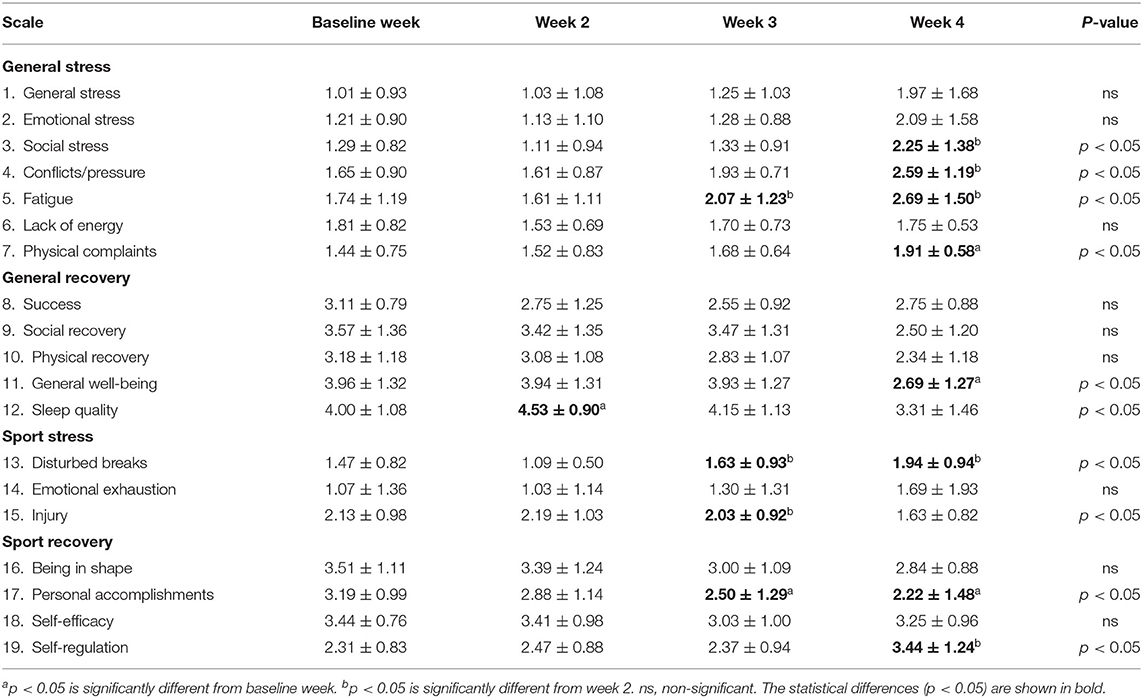
95% of researchers rate our articles as excellent or good
Learn more about the work of our research integrity team to safeguard the quality of each article we publish.
Find out more
CORRECTION article
Front. Physiol. , 31 January 2022
Sec. Exercise Physiology
Volume 13 - 2022 | https://doi.org/10.3389/fphys.2022.834667
This article is part of the Research Topic Management of Training Frequency and Intersession Recovery – Molecular, Cellular and Physiological Implications for Performance and Health View all 6 articles
This article is a correction to:
Increases in RPE Rating Predict Fatigue Accumulation Without Changes in Heart Rate Zone Distribution After 4-Week Low-Intensity High-Volume Training Period in High-Level Rowers
by Pind, R., Hofmann, P., Mäestu, E., Vahtra, E., Purge, P., and Mäestu, J. (2021). Front. Physiol. 12:735565. doi: 10.3389/fphys.2021.735565
In the original article, there was a mistake in Table 1 as published. Some average values in Week 4 column (those with no significant change) have been lost and only standard deviations appear. The corrected Table 1 appears below.

Table 1. Average scores (mean ± SD) of the Recovery-Stress Questionnaire for Athletes (RESTQ-Sport) scales during the 4-week training period.
The authors apologize for this error and state that this does not change the scientific conclusions of the article in any way. The original article has been updated.
All claims expressed in this article are solely those of the authors and do not necessarily represent those of their affiliated organizations, or those of the publisher, the editors and the reviewers. Any product that may be evaluated in this article, or claim that may be made by its manufacturer, is not guaranteed or endorsed by the publisher.
Keywords: training monitoring, intensity, duration, internal load, external load, exercise prescription, session RPE
Citation: Pind R, Hofmann P, Mäestu E, Vahtra E, Purge P and Mäestu J (2022) Corrigendum: Increases in RPE Rating Predict Fatigue Accumulation Without Changes in Heart Rate Zone Distribution After 4-Week Low-Intensity High-Volume Training Period in High-Level Rowers. Front. Physiol. 13:834667. doi: 10.3389/fphys.2022.834667
Received: 13 December 2021; Accepted: 10 January 2022;
Published: 31 January 2022.
Edited and reviewed by: Giuseppe D'Antona, University of Pavia, Italy
Copyright © 2022 Pind, Hofmann, Mäestu, Vahtra, Purge and Mäestu. This is an open-access article distributed under the terms of the Creative Commons Attribution License (CC BY). The use, distribution or reproduction in other forums is permitted, provided the original author(s) and the copyright owner(s) are credited and that the original publication in this journal is cited, in accordance with accepted academic practice. No use, distribution or reproduction is permitted which does not comply with these terms.
*Correspondence: Rasmus Pind, cmFzbXVzLnBpbmRAdXQuZWU=
Disclaimer: All claims expressed in this article are solely those of the authors and do not necessarily represent those of their affiliated organizations, or those of the publisher, the editors and the reviewers. Any product that may be evaluated in this article or claim that may be made by its manufacturer is not guaranteed or endorsed by the publisher.
Research integrity at Frontiers

Learn more about the work of our research integrity team to safeguard the quality of each article we publish.